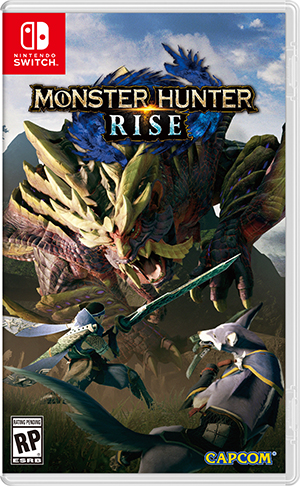The announcement of Monster Hunter Rise brought two main thoughts to mind. First was the excitement at the series’ latest entry coming exclusively to Switch, especially after just how successful Monster Hunter World had been. Second was… how do you follow up Monster Hunter World?
Yes, I too slept on Monster Hunter until World released a few years ago. I don’t regret that but it does mean I missed out on the series’ growth on Nintendo handhelds. It also means I avoided a lot of the more outdated and cumbersome features that World omitted, and while Generations can be found on Switch, I was still more excited to give a game made specifically for the system a go.
Now that I’ve had a chance to play Rise (or rather an early demo version of it), I can answer that earlier question in some respects. Unfortunately, the demo I’ve played didn’t feature anything outside of a couple different Quests. That means no hub, no crafting new armor or weapons, no meals, and no real sense of the game’s plot. Still, it was plenty to get a sense of how World will handle its action and what new tools it’s giving players.
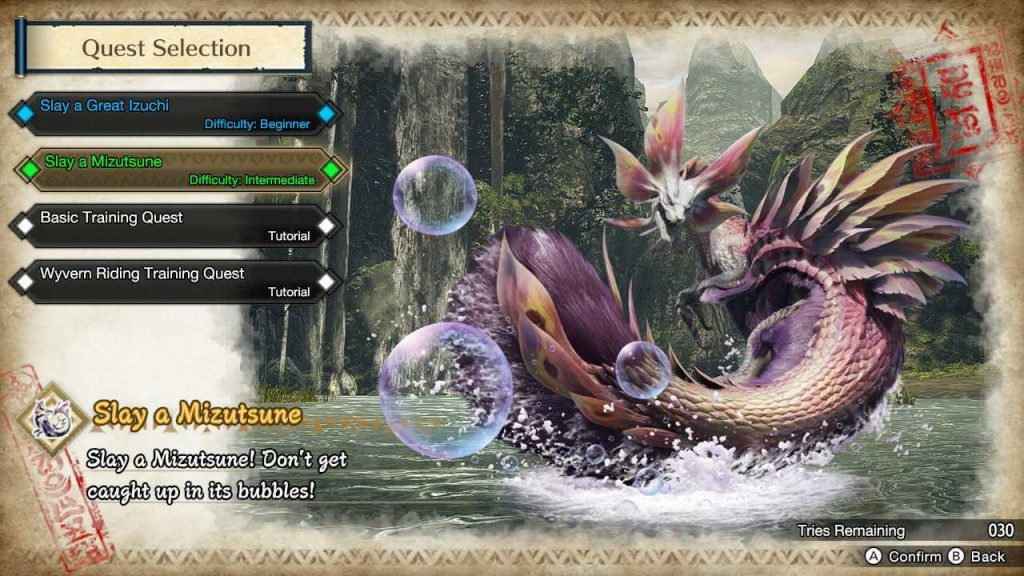
When you start the demo, there are four Quests available – a beginner-friendly hunt against a Great Izuchi, a more advanced encounter with a Mizutsune, and two tutorials based on Quest basics/the new Wirebug feature and a tutorial for the just announced Wyvern Riding. The demo had a hard limit of 30 Quests, though the tutorials didn’t seem to subtract from that total. Failed Quests do, though, so try and make the most of each.
I’ll also note that the demo featured local and online multiplayer, but as of now I was unable to test either. This was due to limited matchmaking options during the early access period, and shouldn’t be an issue for all you hunters now that the demo’s live.
As far as its gameplay goes, though, pretty much everything I’d picked up from playing World for all those hundreds of hours transferred over to Rise well. Though the more polished visuals and lusher, deeper environments weren’t here, the available map was still large and still housed at least three monsters at a time. Textures and animations are less detailed, but everything was at a steady frame rate and actually looked pretty good in action. Traversal was also seamless, meaning no load times between numbered sections.

The main addition to the experience this time are the Wirebug based mechanics. Depending on if your weapon is drawn or sheathed, you’ll have access to universal movement or weapon-specific Silkbind attacks respectively. I experimented with how the Wirebug complimented my two favored weapons (Insect Glaive and Greatsword) and could immediately see some interesting potential.
For one, I had new movement options for both. On Glaive this meant being able to quickly reposition to line up vaults or correct bad ones. Greatsword on the other hand now had ways to close gaps quickly and add some verticality to an engagement. These Wirebug dashes have more options (in terms of direction and followups) to them than rolls, and have other weapon-specific utility as well.
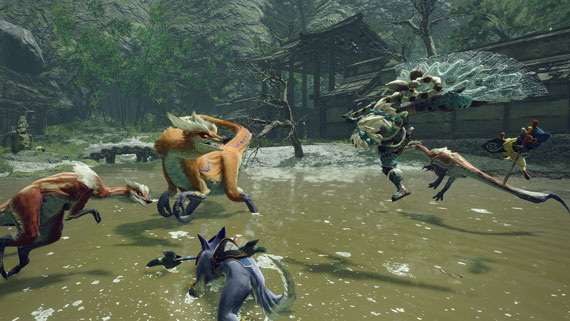
I wasn’t entirely sold on Insect Glaive’s Silkbind techniques during the demo until I experimented with aerial mobility. Being able to use your standard vaults and a few Silkbind based ones has the potential to keep you in the air for much longer, upgrading the weapon’s most notable niche. It also gained a backwards movement option that also recalled the kinsect, something that was useful in a pinch.
The real winner for these Wirebug features, though, was the Greatsword. One memorable moment had me facing down a Rathian. As she prepared a fireball attack I was able to Wirebug out of the way using a Greatsword specific technique (Power Sheathe, a hybrid dodge and self-buff) to both avoid the blast, power up, and put myself in position to strike the Rathian’s head with a charged slash. I’ve hunted more Rathians than I can count at this point, but with one simple addition Rise found a way to make it feel fresh again. GS also now has a reliable (though slow) way to get some air time to hit faster flying monsters.
As intriguing and helpful as these little guys are, they do have some limitations. Wirebugs go on cooldown once used, and you have a set stock available. In the demo that meant I had two by default, raised to three if I found a Wirebug roaming around the map. Managing your available actions and making the most of the new options they provide is going to take some time to fully understand, but it’s an exciting prospect unique to Rise.
The two playable non-tutorial Quests were standard fare. Great Izuchi didn’t offer much of a challenge, though with the default gear available its tail based attacks could be surprisingly potent. It can also continuously support itself by calling lesser Izuchi, though thankfully they go down quick and are more a threat in how they follow up and compliment their leader’s attacks instead of potentially swarming players.
The other hunt, against Mizutsune, is what I imagine most players will play and replay. It puts all three of the monsters I’ve mentioned on the map, though I wasn’t able to incite a World style Turf War despite luring Rathian and Mizutsune together. They did scuffle a bit before one ran off, and it’s possible the feature just didn’t apply to them. There is some further benefit to making them cross paths though, as a new technique in Rise allows you to ride a monster and puppeteer it into attacking others.
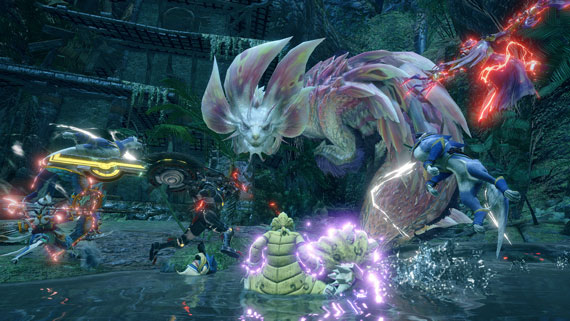
This technique, known as Wyvern Riding, is another new Wirebug-based mechanic in Monster Hunter Rise. By attacking with Silkbind techniques enough or using an item/creature called a Puppet Spider, you can climb onto a monster and control them in a limited fashion. This goes much further than mounting or using the Clutch Claw, as you can actually use the monster’s techniques on command and control them more directly. You won’t suddenly “be” the monster and it is on a timer, but it’s an interesting new addition.
With how Monster Hunter handles resistance to things like mounting and toppling (and having put a lot of time on Insect Glaive, which can make those happen more readily) it’ll be interesting to see how Wyvern Riding works in a group setting. Ultimately though, I got to launch a Rathian at a Great Izuchi and watch them crash into each other – moments/combinations like that are what I’m here for.
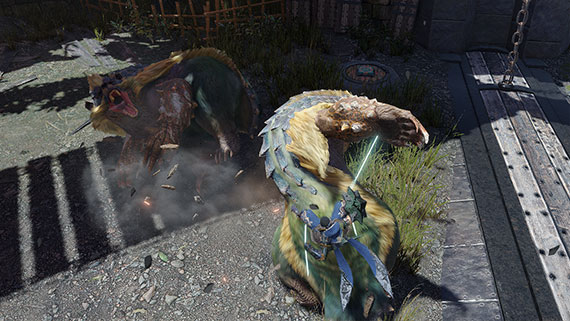
Outside of Quests, I’m enjoying Rise’s aesthetic. Entries for monsters and other lifeforms in your in-game notes and loading screens will no doubt bring Okami’s artstyle to the mind of most video game fans, and this traditional style meshes well with the Japanese theme that’s apparent in the game’s design. One thing that caught me off guard is the voiced lines for hunters now. Yes, your character will now throw out quips and warnings that feel a little bit…off. Maybe it’s the delivery or just not being used to it in the series, but hearing my hunter call a completed Quest “Easy-peasy!” was a little surreal.
The Quest NPC I spoke with had a very ‘radical’ way of speaking too that might fit Monster Hunter to an extent but didn’t quite fit with everything Rise has shown me. These aspects can be avoided (by skipping through dialogue and changing voice options) but maybe they’ll grow on me.
These are but my earliest thoughts on Monster Hunter Rise, and I’m excited to keep trying the demo both on my own and with others. Every weapon is available (though only with a single loadout each) and with how many ways you can approach a hunt there’s plenty of replayability in this download within its 30 available plays/limited availability window.
Anyone even remotely curious should give it a try and make their own judgements, but for now I’m comfortable saying the demo has me eager for more of this latest Monster Hunter. Rise may lose some of World’s bigger ideas and polish, but it makes up for them with its own identity and new gameplay mechanics. Don’t mistake this for a downgrade or concession, as this still feels like a promising continuation of the series in its own right.
Leave a Comment
